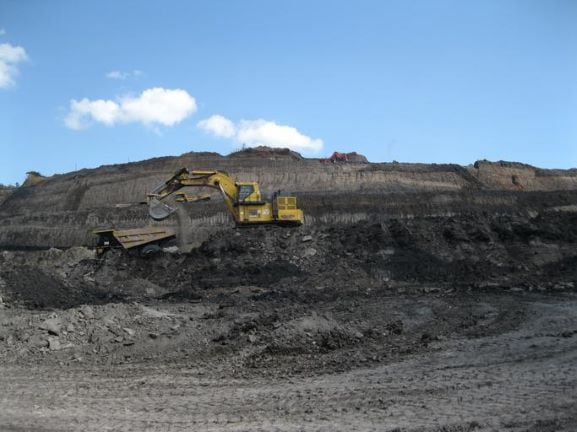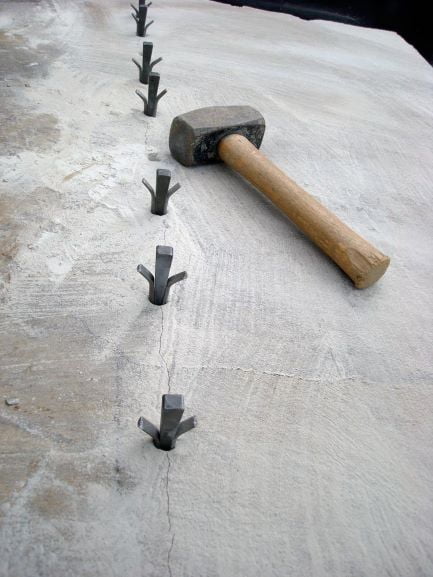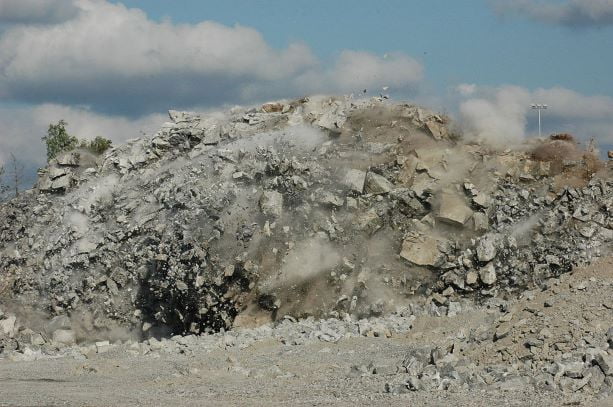Quarrying of Stones

Naturally, stones occur in the form of rock masses. These rock masses are to be broken and extracted to obtain the stones that can be used for construction purposes. Quarrying is the only operation involved in the production of natural stone. Quarrying is the process of extracting suitable stones from their natural place of occurrence. Quarry is the open part of the natural rock from which the stones are obtained. Stone quarrying is usually done in hilly areas where large quantity of stone is available.
What is the difference between quarrying and mining?
The process of quarrying is different from that of mining. Mining is the process of extraction of metal ores occurring below the earth surface. The top surface of the mines remain intact. However, in case of quarrying, the extraction of stones start from the top of the surface.
Selection of quarry site
The following factors are to be considered while selecting a quarry site:
- Availability of good quality stone existing over a sufficiently large area.
- The location of quarry site must necessarily be close to at least any one of transport network (like roadways, railways) and thus enabling easy transport of quarried stones.
- Availability of sufficient water for men, machines and equipments used in quarrying operations.
- Availability of required space for storing broken stones and dumping useless broken fragments obtained during quarrying.
- The site must be far from permanent structures like bridges, dams, etc. because the vibrations due to blasting in the site may cause harm to them
- Availability of adequate drainage facilities for removing underground or surface water immediately after rain.
- Availability of geological data of the site.
Considerations for quarrying stones
After the site selection, certain considerations are to be adopted before quarrying of stones which are listed below:
- Check the presence of any cracks and fissures on the rock surface.
- Prepare the layout involving different stages of quarrying operations.
- Test the machines used for quarrying stones to ensure easy and quick operation.
- If the top surface of site contains soft soil, then it must be removed.
- Remove the stones carefully to prevent the occurrence of landslides or slips which can cause severe damage to the lives of labour.
Methods of quarrying
Depending on the nature and surface of rock and the purpose for which the rock is to be used, quarrying is classified into following types:
Quarrying by using hand tools
This method is suitable for smaller works or for soft stones. The use of hand tools yield well shaped blocks for the construction of masonry. This method of quarrying is further classified into following types:
- By excavation – Excavation method is suitable for soft stone buried in earth or under loose overburden. Tools used in excavation are hammer, pick axe, shovel, crow bars, chisel.
- By heating – Heating of the stone is suitable for quarrying small, thin regular blocks of stones from rocks. The top surface of stone is heated by placing wood with fuel on it and separated from the rock. This separated portion is removed by using pick axes, crowbars. Stones obtained using this method will be in good shape if the rock formation contains horizontal layers at shallow depth. Stone blocks obtained by heating are suitable for coarse rubble masonry. This method is adopted for Granite, Gneiss.
- By wedging – Fissures, cracks, planes of cleavages are all weak points in the rock. By taking advantage of these weak points, steel wedges are driven into these natural fissures or cracks and are hit with sledge hammer, so that rock splits easily. This method is used mostly for sedimentary rocks. The method of wedge quarrying is costly. This method is adopted for sandstone, limestone, marble, slate, laterite.
- By drilling artificial line of holes – This method is adopted when the natural cracks are absent. Sometimes, line of holes (in rows) are drilled with the help of chisel and hammer or using pneumatic drill. The holes are normally 12 mm diameter and 20 to 25 cm deep depending on the type of rock and thickness of stone to be excavated. Steel wedges are driven into these artificial to drilled holes. Then all the wedges are hammered simultaneously resulting in crack formation along the face of holes.
- By swelling hard wooden pegs – Hard wooden pegs are driven into either natural or artificially made fissures. The pegs are soaked with water which results in the splitting of the rock.



Machine quarrying
Machine quarrying is done by using channeling machines which is driven by steam, compressed air or electricity. In this method, a groove is made using channeling machine around the rock and the horizontal holes are drilled underneath the block. The wedges are driven into holes. Hence, the block gets separated from its bed. Larger blocks of stones can also be obtained by this method. Marbles, limestones, etc. are quarried using channeling machine.
Quarrying by blasting
Blasting is adopted when the rock is very hard and does not contain any fissures. Blasting is the process of loosening the hard and closely packed material with the help of explosives. The basic principle employed in blasting is to explode a small quantity of an explosive at a calculated depth within the body of the rock. The force produced due to explosion is sufficient to create cracks and loosen the blocks of rock. The process of blasting must be done with proper safety measures. Blasting is adopted when large scale excavation of stones is to be done.

Operations involved in blasting
The four main operations involved in blasting are boring, charging, tamping and fining.
Boring:
- Holes are drilled or bored in the rock. For vertical holes, jumper is used, whereas for inclined or horizontal holes, boring bars are used.
- Hold the jumper in the place and strike it up and down. The jumper is rotated simultaneously.
- Pour the water into the hole regularly. This softens the rock and facilitates drilling.
- As a result, muddy paste is generated which is removed from holes by scrapping.
- For hard rocks, machine drilling is used instead of hand drilling.
Charging:
- The holes are dried completely before placing the required amount of charge in the holes.
- The holes are dried by tying the rag with the scrapper and is moved in the hole from where it absorbs the moisture.
Tamping:
- After charging, a greased priming needle is placed in the hole such that a small portion of the needle is projected outside.
- Fill the hole with damp clay or stone dust in layers and tamp sufficiently with a tamping rod. Rotate the priming needle continuously while tamping to ensure that the needle remains loose in the hole.
- The priming needle is then taken out and about 60 to 75 percent of the space created by withdrawing the needle is filled with gun powder. A Bickford fuse is placed just touching the needle. The other end of the fuse is kept at sufficient length so that the person igniting it can move away to a safe place.
Firing:
- Blasting powder and cordite are ignited by using a fuse, whereas gun cotton and dynamite are exploded by detonation.
Storage of explosives
- The explosives must be stored in a special type of building which must be away from residential areas, petrol depots, etc.
- The storage building must have ventilators at high levels, must have concealed wiring and must be protected from lightning. It must be surrounded by barbed wire and the entry should he restricted. Smoke or fire should not be allowed in the nearby area.
- Explosives must be protected from extreme heat or cold and moisture. They should be handled carefully and gently.
Quantity of explosives required
- The quantity of explosive required depends upon the following factors:
- Strength of explosive
- Method of blasting
- Number of bore holes and their sizes, position
- Type and mass of rock to be dislodged.
- As a rough estimate, the quantity of gun powder used for blasting is
A = L2/0.008
Where, A – Quantity of gun powder or dynamite in grams and L –length of line of least resistance in metres.
Commonly used explosives
Few of the commonly used explosives are as follows:
- Gun powder (or) Blasting powder – mixture of potassium nitrate, charcoal and sulphur.
- Blasting cotton (or) Gun cotton– cotton saturated with nitric acid.
- Dynamite – mixture of nitroglycerine, sandy earth.
- Cordite – Gelatinised combination of nitroglycerine and nitrocellulose.






Whats up very nice web site!! Guy .. Beautiful ..
Superb .. I will bookmark your web site and take the feeds additionally?
I’m glad to search out a lot of helpful information here in the
publish, we want work out extra strategies in this regard, thank you for sharing.
. . . . .
Hi Antonio,
Great to hear from you. Looking forward to reach out to you, Antonio.
You really make it seem really easy together with your presentation however I find this matter to be really something which I think I might by no means understand. It kind of feels too complicated and very large for me. I’m having a look forward to your subsequent post, I’ll attempt to get the hold of it!
Hello Senaida,
Its our pleasure that you liked our presentation. We will make sure to bring up the interesting topics in upcoming days and will also let you get notified. Hope you will enjoy.